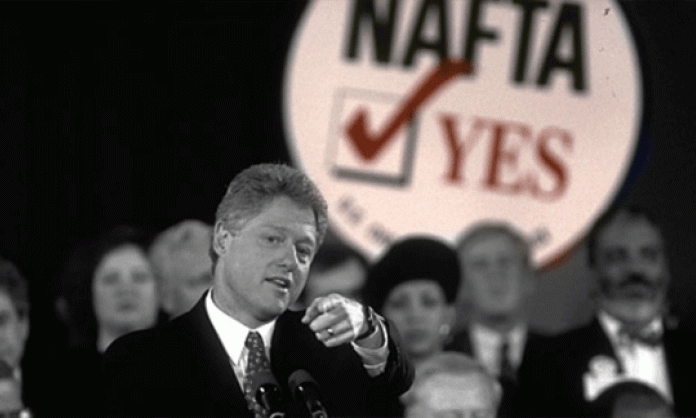The Trans-Pacific Partnership (TPP), currently being negotiated between the US and 11 other countries, is a treaty covering cross-border regulations and investment.
While it is being negotiated in secret, the capitalists are highly involved. For the US side alone, some 600 corporate representatives are neck deep in the negotiations.
The TPP has been referred to as “NAFTA (North American Free Trade Agreement) on steroids”.
NAFTA was an agreement between the US, Canada and Mexico. When he signed the agreement at the end of 1993, president Bill Clinton promised it would “promote more growth, more equality, better preservation of the environment and greater possibility of world peace … It will create 200,000 jobs in this country by 1995”.
What is the result 20 years on? Within all three countries, wealth inequality has mushroomed, not decreased. In no year did the US add 200,000 jobs as a result of NAFTA. In fact, hundreds of thousands of jobs were lost as US corporations used NAFTA’s investment incentives to relocate to Mexico to take advantage of low wages. No environmental laws were strengthened.
Big pharma and chemical industries got patents extended geographically, and won rights not to be regulated and inspected. Big oil and gas got absolute rights to natural resources, to pump ever more greenhouse gases into the atmosphere.
Mexican president Carlos Salinas at the time echoed Clinton. In a speech given in the US, he said: “NAFTA is a job-creating agreement” for Mexico. “It is an environmental improvement agreement.” Most important, he boasted, “It is a wage-increasing agreement”.
It is in Mexico, however, that NAFTA has wreaked the most damage.
Mexican disaster
NAFTA promoters argued that the pact would bring new US technology and capital to complement Mexico’s surplus labour. This in turn would lead Mexico to industrialise and increase productivity, which would result in rising wages. The higher wages would expand economic opportunities and slow migration to the US.
The results are in. NAFTA failed to spur meaningful or inclusive economic growth, pull Mexicans out of unemployment and underemployment or reduce poverty. It has done the opposite.
An immediate result of NAFTA was to gut the land reform embedded in the Mexican constitution, a vestige of the Mexican revolution of the early 20th century, guaranteeing small plots to millions of rural labourers.
It also opened Mexico to the importation of cheaper US corn (maize), a staple of the Mexican diet. As corn prices plummeted, indebted farmers lost their land, which could now be acquired under NAFTA by rich Mexicans and US agribusiness owners, who consolidated prime acres into large plantations.
Between 1995 and 2005, 1.1 million peasants lost their land, and another 1.4 million dependent on the farm sector were driven out of work. They swelled the ranks of the poor being driven into the cities or pushed to seek emigration to the US as undocumented workers with scarce legal rights.
The urban poor have difficulty finding jobs. Many are in the “informal” sector, selling candy and trinkets on the streets. Their number has increased since 1994 to half of the workforce.
Wages dropped so precipitously that today the income of a farm labourer is one-third of what it was before NAFTA.
Although the price of corn plummeted, the price of corn tortillas, a Mexican staple, skyrocketed in the pact’s first 10 years. NAFTA included service sector and investment rules that facilitated the consolidation of grain trading, milling, baking and retailing so that in short order the relatively few remaining large firms were able to raise consumer prices. The result has been an increase in the number of people going hungry. At the higher prices, it is profitable for US firms to make tortillas and export them to Mexico.
The decline of Mexican agriculture has meant an increasing amount of food is imported from the US, including processed food. The irony is that obesity is increasing amid hunger.
Today over half of the population, and 60 percent of the rural population, live below the poverty line. One in four is classified as extremely poor, unable to afford adequate food; 20 percent of children are malnourished. From 2006 to 2010, more than 12 million people joined the ranks of the impoverished.
A minimum wage worker can buy 38 percent fewer consumer goods today than before NAFTA. Clinton and Salinas promised that NAFTA would decrease the wage differential between Mexico and the United States enough to slow emigration, but this differential has barely budged.
Mexican manufacturing workers made an average of US$4.53 an hour in 2011, while comparable US workers made $26.87. In Brazil, manufacturing wages were double those in Mexico, while they were triple in Argentina.
The flood of desperate people into the US has accelerated, not decreased.
It is true that the better off have made gains. While tens of thousands of small businesses have gone under, big US firms like Walmart and Costco have moved in, selling goods imported from Asia to the “new middle class”.
Social instability also has been exacerbated in the country, furthered by the US “war on drugs”. One of Mexico’s big imports from the US is weapons.
Given Mexico’s record on “growth, equality, wages and peace” under NAFTA, small wonder that the TPP is viewed with trepidation.










